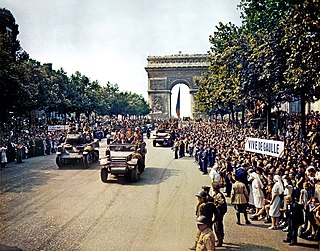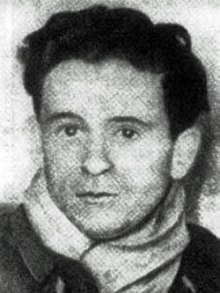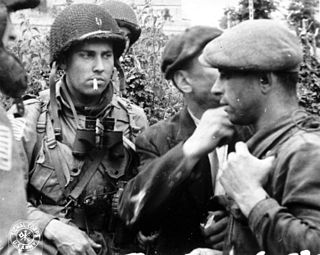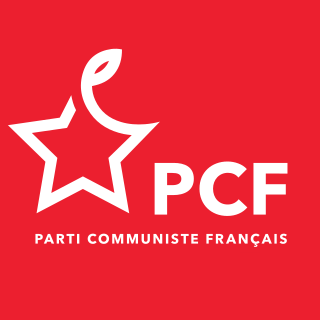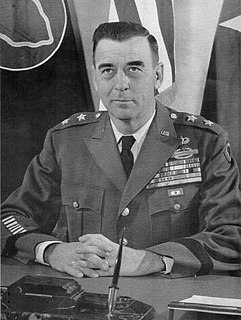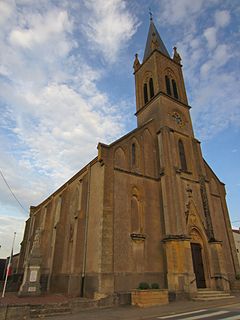
The Luxembourg Army is the national military force of Luxembourg. The army has been an all-volunteer force since 1967. It has a current strength of approximately 450 professional soldiers—340 enlisted recruits and 100 civilians—with a total budget of $369 million, or 0.9% of GDP.

Free France and its Free French Forces were the government-in-exile led by Charles de Gaulle during the Second World War and its military forces, that continued to fight against the Axis powers as one of the Allies after the fall of France. Set up in London in June 1940, it organised and supported the Resistance in occupied France.

The Battle of Saalfeld took place on the 10 October 1806, at which a French force of 12,800 men commanded by Marshal Jean Lannes defeated a Prussian-Saxon force of 8,300 men under Prince Louis Ferdinand. The battle took place in Thuringia in what was the Ernestine duchy of Saxe-Coburg-Saalfeld. The battle was the second clash in the Prussian Campaign of the War of the Fourth Coalition.

The First Army was a field army of France that fought during World War I and World War II. It was also active during the Cold War.

The French Forces of the Interior refers to French resistance fighters in the later stages of World War II. Charles de Gaulle used it as a formal name for the resistance fighters. The change in designation of these groups to FFI occurred as France's status changed from that of an occupied nation to one of a nation being liberated by the Allied armies. As regions of France were liberated, the FFI were more formally organized into light infantry units and served as a valuable manpower addition to regular Free French forces. In this role, the FFI units manned less active areas of the front lines, allowing regular French army units to practice economy of force measures and mass their troops in decisive areas of the front. Finally, from October 1944 and with the greater part of France liberated, the FFI units were amalgamated into the French regular forces continuing the fight on the Western Front, thus ending the era of the French irregulars in World War II.

The French 2nd Armored Division, commanded by General Philippe Leclerc, fought during the final phases of World War II in the Western Front. The division was formed around a core of units that had fought in the North African campaign, and re-organized into a light armored division in 1943. The division embarked in April 1944 and shipped to various ports in Britain. On 29 July 1944, bound for France, the division embarked at Southampton. During combat in 1944, the division liberated Paris, defeated a Panzer brigade during the armored clashes in Lorraine, forced the Saverne Gap and liberated Strasbourg. After taking part in the Battle of the Colmar Pocket, the division was moved west and assaulted the German-held Atlantic port of Royan, before recrossing France in April 1945 and participating in the final fighting in southern Germany, even going first into Hitler's "Eagle's Nest". Deactivated after the war, the 2nd Division was again activated in the 1970s and served through 1999, when it was downsized to the now 2nd Armored Brigade.

The Russian Expeditionary Force was a World War I military force sent to France by the Russian Empire. In 1915 the French requested that Russian troops be sent to fight alongside their own army on the Western Front. Initially they asked for 300,000 men, an unrealistically high figure, probably based on assumptions about Russia's 'unlimited' reserves. General Mikhail Alekseev, the Imperial Chief of Staff, was opposed to sending any Russian troops, although Nicholas II finally agreed to send a unit of brigade strength. The First Russian Special Brigade finally landed at Marseille in April 1916. A Second Special Brigade was also sent to serve alongside other Allied formations on the Salonika Front in northern Greece. In France, the First Brigade participated in the Nivelle Offensive, however with news of the Russian Revolution of 1917 affecting the demoralisation within the French Army following the failure of that offensive, the 1st and 3rd Brigades participated in the wave of mutinies spreading across France. The First Brigade was finally disbanded before the end of the year. However, the Honorary Russian Legion of the 1st Moroccan Division continued to maintain a Russian presence in the west and, indeed in the First World War itself, until the Armistice of 11 November 1918.

The Alsace-Lorraine Independent Brigade, usually known as the Alsace-Lorraine Brigade or sometimes as the Brigade Malraux, was a French Forces of the Interior (FFI) unit that fought alongside regular French Army forces in World War II during the closing months of 1944 and early 1945.

The 3rd Algerian Infantry Division was an infantry division of the Army of Africa which participated in World War II.

The 27th Mountain Infantry Brigade is a mountain infantry formation of the French Army. It is heir to the traditions of the 27th Alpine Division FFI, created in 09/1944, renamed 27th Alpine Infantry Division in 12/1944, 27th Alpine Brigade in 12/1962, 27th Alpine Division in 08/1976. and then the 27th division d'infanterie de montagne in 07/1994. With the end of conscription, all of the French Army's divisions were downsized and the 27th became a brigade in 1999.

The Battle of Phu Hoai was an indecisive engagement between the Tonkin Expeditionary Corps and Liu Yongfu's Black Flag Army during the early months of the Tonkin campaign (1883–1886). The battle took place during the period of increasing tension between France and China that eventually culminated in the Sino-French War.

The Tonkin Expeditionary Corps was an important French military command based in northern Vietnam (Tonkin) from June 1883 to April 1886. The expeditionary corps fought the Tonkin Campaign (1883–86) taking part in campaigns against the Black Flag Army and the Chinese Yunnan and Guangxi Armies during the Sino-French War and the period of undeclared hostilities that preceded it, and in important operations against Vietnamese guerrilla bands during the subsequent 'Pacification of Tonkin'.
After the fall of France, many Poles who were not involved in the regular Polish Army in France during World War II, or who were unable to reach the United Kingdom where the Polish Army in the United Kingdom had been formed, became the pillars of the Polish resistance in France.
The Battle of Marseille is the combat and other actions from August 21–28, 1944 which led to the liberation of Marseille by French forces in the Second World War. The groundwork was laid by the Allied invasion of southern France in Operation Dragoon on 15 August 1944 by the United States Seventh Army, with major support from the French First Army.
Adrien Pommier was a member of the French Resistance during World War II.

